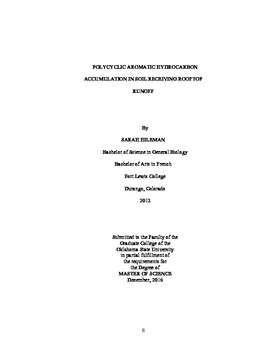| dc.contributor.advisor | Belden, Jason B. | |
| dc.contributor.author | Hileman, Sarah Thurau | |
| dc.date.accessioned | 2018-06-29T14:41:00Z | |
| dc.date.available | 2018-06-29T14:41:00Z | |
| dc.date.issued | 2016-12-01 | |
| dc.identifier.uri | https://hdl.handle.net/11244/300351 | |
| dc.description.abstract | Polycyclic aromatic hydrocarbons (PAHs) are persistent organic pollutants that are ubiquitous in the environment and can potentially impact human health. The main objective of this study was to qualify and quantify PAH accumulation (especially the seven potentially carcinogenic PAHs (cPAHs)) throughout the Oklahoma City Metro Area and to investigate factors that could be related to higher accumulation. Factors included building use (residential, commercial, and school) and roofing type (asphalt, metal, and tar). To determine if cPAH concentrations were higher in soil receiving direct rooftop runoff, paired runoff receiving contact samples and reference samples (not receiving rooftop runoff) were evaluated from each site. In addition to determining the presence of certain PAHs, a digestive model was applied to give an indication as to what percent of the overall PAHs become bioavailable if contaminated soil is ingested. Overall 77% of the locations analyzed had levels of cPAHs above the USEPA’s soil screening level (SSL). Benzo[a]pyrene (BaP), a known carcinogenic PAH, appeared above SSL in 74% of the samples, with the 95th percentile of runoff contact samples at 880 ppb. Contact soil samples surrounding schools had the highest significant values of cPAHs contamination within building usage, with 95th percentile concentrations of cPAH for soil receiving rooftop runoff at 140,000 ppb. Schools and commercial contact soils had significantly elevated levels of cPAHs and BaP as compared to residential contact soils. Roof type did not vary in contributing to cPAH or BaP levels in contact samples. cPAHs and BaP concentrations in contact soils were significantly greater within each sampling subset compared to the paired reference sample. The digestive model indicated that some of the soils with the highest concentrations of cPAHs and BaP had less than 3% bioavailability. Values of some samples were still more than 100 ppb bioavailable, but there was a great decrease in concentration of cPAHs within the bioavailable fraction. Because many high concentrated cPAH soils were found in school areas, school sites should be further investigated for contamination. While these sites may not show high potentials for bioavailability, the magnitude of cPAH concentrations in soil is still a cause for concern. | |
| dc.format | application/pdf | |
| dc.language | en_US | |
| dc.rights | Copyright is held by the author who has granted the Oklahoma State University Library the non-exclusive right to share this material in its institutional repository. Contact Digital Library Services at lib-dls@okstate.edu or 405-744-9161 for the permission policy on the use, reproduction or distribution of this material. | |
| dc.title | Polycyclic Aromatic Hydrocarbon Accumulation in Soil Receiving Rooftop Runoff | |
| dc.contributor.committeeMember | Vogel, Jason R. | |
| dc.contributor.committeeMember | McMurry, Scott T. | |
| osu.filename | Hileman_okstate_0664M_14977.pdf | |
| osu.accesstype | Open Access | |
| dc.description.department | Zoology | |
| dc.type.genre | Thesis | |
| dc.type.material | text | |
